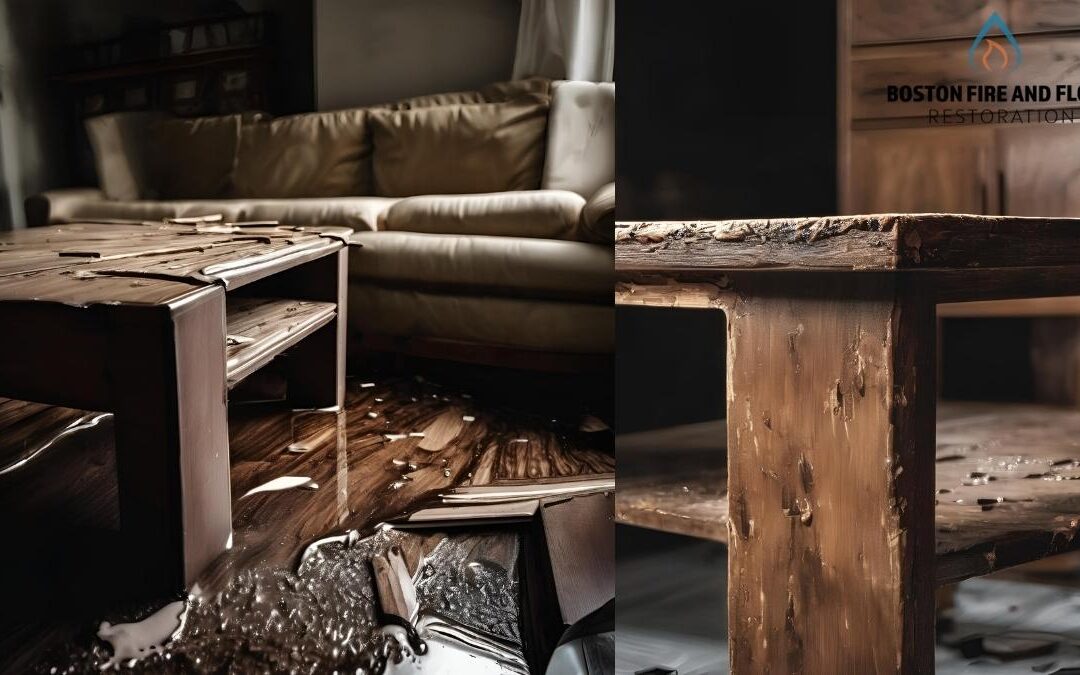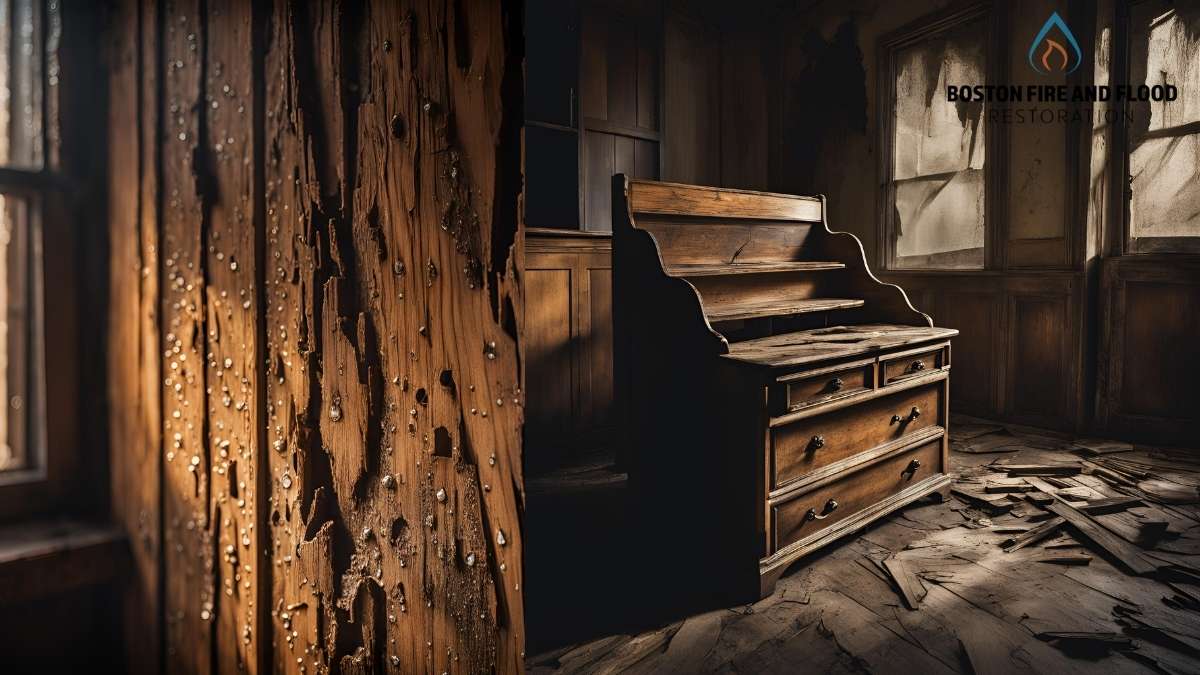In this guide, we’ll explain how to Repair water-damaged swollen wood furniture step by step so that you can bring your items back to life. Water damage and swollen wood furniture can be a headache. When moisture seeps into the wood, it can cause swelling, warping, and even mold growth, affecting both the appearance and structure of your beloved pieces. Fortunately, you can restore most damaged furniture with the right tools and techniques.
What Causes Wood Furniture to Swell?
Understanding the Problem
Water and wood don’t mix well. When wood absorbs water, it expands, leading to swelling, warping, and cracks. Common causes include spills, leaks, high humidity, and even improper storage. The damage can range from slight swelling to severe warping, making your furniture look distorted and uneven. Understanding this problem can bring a sense of relief, as it’s the first step towards finding a solution.
The type of wood also matters. Solid wood can swell and contract depending on the moisture content, while engineered wood like plywood and MDF may delaminate or crumble when exposed to water. Understanding what you’re dealing with is the first step in knowing how to proceed with repairs.
Essential Tools and Materials for Repair
Before diving into the repair process, gather the right tools and materials to ensure smooth and effective results:
Checklist of Tools
- Tools:
- Sandpaper (various grits)
- Clamps
- Wood glue
- Putty knife
- Paintbrushes
- Dehumidifier or fan
- Protective Equipment:
- Gloves
- Safety goggles
- Mask (to avoid inhaling wood dust)
Having these items on hand will make the process easier and faster. Plus, it ensures that you can achieve professional-looking results.
Step-by-Step Guide: How to Repair Water Damaged Swollen Wood Furniture
Assess the Damage
Before jumping into repairs, scrutinize your furniture. Identify how much of the wood is swollen, warped, or cracked. Minor swelling can often be fixed with sanding, while severe cases might need more extensive treatment. This will help you decide whether to do DIY or consider professional help.
Dry Out the Wood
The first natural step in repairing swollen wood is to dry it out completely. Use a dehumidifier, fan, or even natural air to extract moisture from the wood. Avoid using direct heat like a blow dryer, as this can cause further warping or cracks.
Tip: Place the furniture in a well-ventilated room with consistent air circulation to speed up the drying process.
Sand Down the Swollen Area
Once the wood is dry, use sandpaper to smooth out the swollen areas. Start with a coarser grit to remove the bulging sections, then gradually switch to a finer grit for a smooth finish. Be gentle; you want to avoid over-sanding, which could damage the wood’s surface further.
Repair Cracks and Gaps
Swelling can cause cracks and gaps. Fill these with wood filler or glue, depending on the size. Apply the filler using a putty knife, and make sure it spreads evenly. For more substantial gaps, consider using wood glue and clamps to hold the pieces together as they set.
Tip: Choose a filler or glue that matches the wood colour for a seamless look.
Refinish the Wood Surface
After the wood is sanded and gaps are filled, it’s time to refinish. Use paint, stain, or varnish to restore the wood’s original appearance. If possible, apply a protective coating to make the furniture more resistant to future water damage. This step not only improves the look but also strengthens the wood.
Tip: Always test the stain or paint on a small, hidden area before applying it to the entire surface to ensure colour consistency.
Final Touches and Inspections
Once the refinishing is complete, inspect the furniture. Ensure there are no rough patches, uneven surfaces, or missed spots. Finish with a final polish or coat of varnish if needed. Your goal is to make the repair as invisible as possible.
Preventing Future Water Damage to Wood Furniture
Tips for Protection
- Use Protective Coatings: Applying a waterproof sealant or finish can safeguard your wood furniture against moisture. Regular maintenance can prevent swelling.
- Proper Placement: Avoid placing wood furniture in damp areas, like basements or rooms with high humidity. Use coasters and mats to protect against spills.
- Maintenance Tips: Regularly dust, clean, and inspect your furniture for signs of moisture or damage. Early detection can prevent major repairs.
When to Call a Professional
Knowing When DIY Isn’t Enough
Sometimes, the damage is too severe for a DIY fix. Considerable warping, severe mold, or significant structural issues require expert intervention. A professional wood restoration service can assess the situation, use specialized tools, and perform repairs that ensure your furniture looks and functions like new.
Benefits of Hiring a Professional:
- Expert assessment of damage
- Access to high-quality materials
- Skilled repair techniques
FAQs: Common Questions About How to Repair Water-Damaged Swollen Wood Furniture
Can Swollen Wood Be Repaired?
Yes, minor swelling can usually be repaired by drying and sanding. Severe cases might require professional help, but it’s important to remember that repair is often possible.
How Long Does It Take to Repair Water Damaged Furniture?
It depends on the extent of the damage and the repair method. Minor fixes take a few hours, while significant repairs take several days.
What Is the Best Way to Prevent Water Damage?
Using protective coatings, ensuring proper placement, and regular maintenance are crucial to preventing water damage.
Conclusion
Water damage doesn’t have to mean the end for your wood furniture. By following the steps in this guide, you can fix water damaged swollen wood furniture and restore it to its original state. Remember, timely action is crucial. If the damage seems too severe or you’re unsure how to proceed, don’t hesitate to contact professionals who can handle the repairs safely and effectively.
Need help with water-damaged furniture? Contact our experts for professional restoration services. We’ll bring your furniture back to life.


